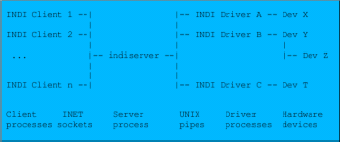1. Architecture
INDI server is the public network access point where one or more INDI clients may contact one or more INDI Drivers. indiserver launches each driver process and arranges for it to receive the INDI protocol from clients on its standard input (stdin) and expects to find commands destined for clients on the driver's standard output (stdout).
Anything arriving from a driver process' stderr is copied to indiserver's stderr. indiserver only provides convenient port, fork, and data steering services. If desired, a client may run and connect to INDI Drivers directly.
Typical INDI Client / Server / Driver / Device connectivity is illustrated in Figure 2:

2. Syntax
The syntax for INDI server is as following:
$ indiserver [options] driver [driver ...] Options: -l d : log driver messages to <d>/YYYY-MM-DD.islog -m m : kill client if gets more than this many MB behind, default 10 -p p : alternate IP port, default 7624 -f path : Path to fifo for dynamic startup and shutdown of drivers. -r r : maximum driver restarts on error, default 10. -v : show key events, no traffic -vv : -v + key message content -vvv : -vv + complete xml driver : executable or device@host[:port]
Each additional argument can be either the name of a local program to run or a specification of an INDI Device on a remote indiserver. A local program is specified as the path name of the execuble to run. The program is presumed to implement the INDI protocol on its stdin and stdout channels, and may send ad-hoc out-of-band error or trace messages to its stderr which gets merged in with the indiserver stderr.
A remote Device is given in the form device@host[:port], where device is the INDI device already available on another running instance of indiserver, host is the TCP host name on which said instance is running and the optional port is the port on which to connect if other than the standard port 7624.
Note well that local programs specify the name of the executable file, not the Device it implements. Conversely, remote connections specify the name of the Device, irrespective of the name of its Driver program.
indiserver is intended to run forever and so never exits normally. If it does exit, it prints a message to stderr and exits with status 1.
3. Dynamic driver startup & shutdown
To use INDI server in FIFO mode, first create a FIFO. For example, under Linux:
$ mkfifo /tmp/myFIFO
Then pass the -f parameter along with the path name of the FIFO:
$ indiserver -f /tmp/myFIFO
A client/script can write to this FIFO to request starting and shutting down of drivers using the following syntax:
- To start a driver:
start driver_path_name -n ["driver_name"] -c ["driver_config_path_name"] -s ["skeleton_file_path_name"]
- To stop a driver:
stop driver_path_name -n ["driver_name"]
The driver_name parameter is optional and specifies the name of the driver to be defined to the client. The optinal driver_config_path_name specifies the configuration file to be used, if any. Finally, skeleton_file_path_name designates the skeleton file to be used for this driver if desired. These variables are set to environment variables INDIDEV, INDICONFIG, and INDISKEL respectively. It is important to note that INDI server only defines these environment variables, and it is up to the driver to read and utilize them upon startup. All drivers based on INDI::DefaultDriver automatically check the environment variable and set the device name accordingly.
It is critical to enclose all optional variables (driver_name, driver_config_path_name, and skeleton_file_path_name) with double quotation marks when issuing FIFO commands.
For example, to start indi_lx200generic driver, but with two driver names (LX90 and "My ETX 90"), we write to FIFO
start indi_lx200generic -n "LX90" start indi_lx200generic -n "My ETX 90"
When redirecting commands to FIFO via echo, ensure to add blackslash to quotes so that they do not get escaped:
echo "start indi_lx200generic -n \"My ETX 90\"" > myFIFO
To stop a driver, you must specify the driver_path_name at least. But if you are running more than one instance of the driver, you should also specify the driver_name. If no driver_name is specified, the first driver in INDI server that matches driver_path_name will be stopped. For example, to stop "My ETX 90":
stop indi_lx200generic "My ETX 90"
